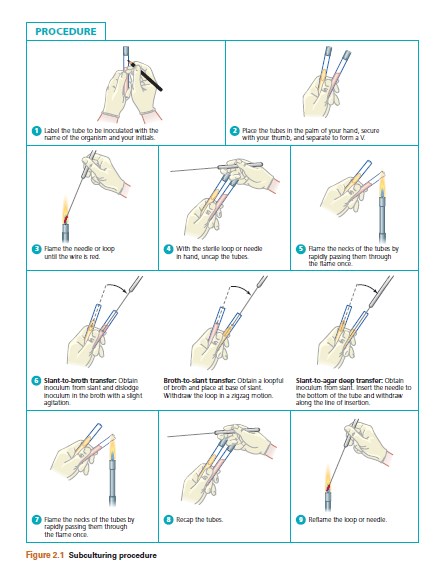Aim
Transfer of microbial cells from a parent culture medium to a fresh broth culture.
Principle
The broth is a liquid medium, which is used to grown microorganisms within the laboratory on a small scale. It also used in an industrial fermentor on a large scale. The media called broths, milks, or nutrient solutions are prepared by dissolving different solutes in distilled water and later sterilizing (autoclaving) it.
Suitable physical and chemical conditions are needed for breeding microorganisms in a broth. Temperature is the most important requirement for spreading cultures which is provided by an incubator in a laboratory.
Many broth cultures also need oxygen, a specific amount of which is incorporated within the surfaces of broth in test tubes arranged in an untroubled rack on the incubator rack, this situation is known as static incubation.
Roller drum equipment in which cultures are arranged at an angle and revolved are used to administer oxygen to broth cultures, a method is employed for aeration of broth cultures. For higher amounts of broth, air is purified, sterilized, and drew within a large broth-filled vessel known as fermentors or bioreactors.
Growth of the microorganisms completed throughout the vessel and may offer a dispersed cloudy or particulate appearance. Some microorganisms consistently raise the turbidity (milkiness or cloudiness) of the broth, due to an improvement in their numbers.
Pellicle, a network of cells, is developed by some microorganisms which arise only at the surface of static broth culture. Additional microbial species may fall to the bottom of the tube to form sediment or button of cells that attach together. Filamentous fungi form intertwined mycelia (clumps) suspended within a broth.
Requirements
- Nutrient broth cultures
- Nutrient broth in test tubes.
- Bunsen burner
- Inoculating loop
- Wax marking pencil.
Nutrient broth Composition
| Ingredients | gl-1 |
| Peptic digest of animal tissue | 5.00 |
| Yeast Extract | 1.50 |
| Beef extract | 1.50 |
| Sodium chloride | 5.00 |
| Final pH (at 25°C) | 7.4 ± 0.2 |
Nutrient broth Preparation
The ingredients were dissolved in distilled water, dispensed as 5.0 ml aliquots in the test tubes (18 x 150 mm), plugged with cotton, and autoclaved at 121°C for 20 min.
Procedure
- Label each nutrient broth tube with the name of the organism.
- Thoroughly mix the broth culture by thumping the bottom of the tube
- Hold both the culture and the broth tube in the left hand.
- Sterilize your loop, by holding in the right hand, remove both plugs (or caps) from these tubes by grasping them between the fingers of right hand.
- Alternately flame the mouth of both tubes.
- Transfer a loopful of culture into the sterile broth with the sterile loop.
- Alternately flame the mouth of both tubes and replace both caps to respective tubes.
- Apply flame to sterilize the inoculating loop immediately after the transfer.
- Incubate the tubes, including control, in a bacteriological BOD incubator at 30°C for 24 hours.

Observation
Observe the broth cultures for the growth of microorganisms, without bothering them. Return these tubes to the incubator. Note any alteration in appearance (growth) from those observed 24 hours after incubation. Mix the broth cultures and examine for the change in appearance both before and after resuspension.
Precautions
- After shifting the culture, always replace the caps with the right tubes.
- Never forget to sterilize the inoculating loop before replacing it with the holder.
- Do not shake the broth cultures till you have examined the results of growth.
Application
- Used to study the characteristics of microorganisms.
- Used for the production of different industrial products by the microorganisms, such as the production of antibiotics, mass production of baker’s yeasts.
References
- https://www.iitg.ac.in/biotech/MTechLabProtocols/Expt-1%20(Culture-Transfer).pdf
- https://vlab.amrita.edu/?sub=3&brch=73&sim=212&cnt=2
- Experiments in Microbiology, Plant Pathology and Biotechnology by K.R. Aneja
- Text Highlighting: Select any text in the post content to highlight it
- Text Annotation: Select text and add comments with annotations
- Comment Management: Edit or delete your own comments
- Highlight Management: Remove your own highlights
How to use: Simply select any text in the post content above, and you'll see annotation options. Login here or create an account to get started.